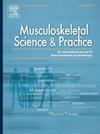Pain science knowledge among healthcare Professionals: A cross-sectional survey within the United States department of veterans Affairs
IF 2.2
3区 医学
Q1 REHABILITATION
引用次数: 0
Abstract
Background
Pain complaints are one of the primary reasons that military veterans seek healthcare within the United States Veterans Health Administration (VHA). VHA providers therefore need to be able to appropriately identify and classify clinical pain presentations and provide evidence-based management strategies.
Objective
The objective of this exploratory quality improvement (QI) project was to identify gaps in pain science knowledge across healthcare professionals who participate in the pharmacological and non-pharmacological management of pain within the United States VHA.
Design
Cross-sectional survey.
Results/findings
Healthcare providers (n = 311; 2 % response rate) representing 17 professions completed the survey. Significant between group difference was demonstrated by profession (H = 23.46; p < .001), and by provider age (H = 65.29; p < .001) in self-reported confidence measures and revised neurophysiology of pain (rNPQ) scores (p < .001). None of the professions reported confidence identifying/treating nociplastic pain and a single profession (pharmacists) reported confidence differentiating between pain phenotypes. Overall, the mean rNPQ score was 9.0 out of 12. Physical therapists (9.9) and psychologists (9.2) scored highest while nurse practitioners (7.3) and clinical social workers (7.6) scored lowest. Individuals 31–40 years old scored the highest (9.0) while individuals greater than 60 years old scored the lowest (7.2).
Conclusion
Pain knowledge within the VHA varies by profession and age. Educational opportunities within the VHA should be catered towards professions likely to benefit the most, including non-physician primary care providers. Educational opportunities should focus on terminology, differentiating between pain phenotypes, and understanding nociplastic pain phenotypes.
医疗保健专业人员的疼痛科学知识:美国退伍军人事务部的横断面调查。
背景:疼痛投诉是退伍军人寻求医疗保健在美国退伍军人健康管理局(VHA)的主要原因之一。因此,VHA提供者需要能够适当地识别和分类临床疼痛表现,并提供循证管理策略。目的:本探索性质量改进(QI)项目的目的是确定美国VHA内参与疼痛药物和非药物管理的医疗保健专业人员在疼痛科学知识方面的差距。设计:横断面调查。结果/发现:代表17个专业的医疗保健提供者(n = 311; 2%回复率)完成了调查。结论:VHA内部的疼痛知识存在不同职业和年龄的差异。VHA内的教育机会应面向可能受益最大的专业,包括非医生初级保健提供者。教育机会应侧重于术语,区分疼痛表型,并了解致伤性疼痛表型。
本文章由计算机程序翻译,如有差异,请以英文原文为准。
求助全文
约1分钟内获得全文
求助全文
来源期刊

Musculoskeletal Science and Practice
Health Professions-Physical Therapy, Sports Therapy and Rehabilitation
CiteScore
4.10
自引率
8.70%
发文量
152
审稿时长
48 days
期刊介绍:
Musculoskeletal Science & Practice, international journal of musculoskeletal physiotherapy, is a peer-reviewed international journal (previously Manual Therapy), publishing high quality original research, review and Masterclass articles that contribute to improving the clinical understanding of appropriate care processes for musculoskeletal disorders. The journal publishes articles that influence or add to the body of evidence on diagnostic and therapeutic processes, patient centered care, guidelines for musculoskeletal therapeutics and theoretical models that support developments in assessment, diagnosis, clinical reasoning and interventions.
 求助内容:
求助内容: 应助结果提醒方式:
应助结果提醒方式:


